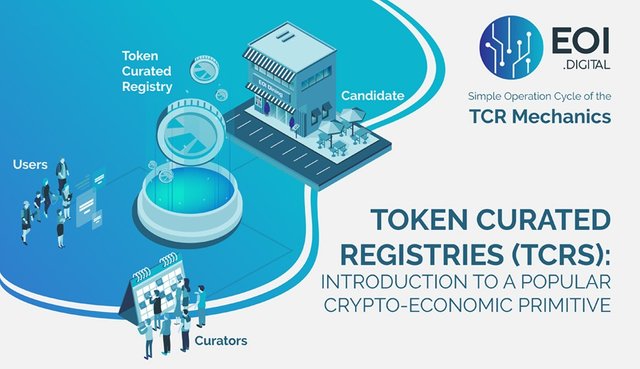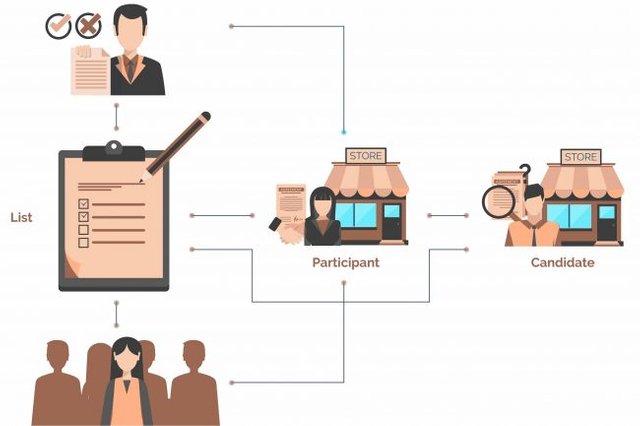
Introduction into Token Curated Registries
The key characteristic of modern economy is high efficiency of productive forces in conjunction with high level of availability of capital goods. This is especially relevant for some industries (IT, digital content creation). This fact leads to supply becoming persistently higher than demand in most of the known consumer markets. PR, as well as customer acquisition and retention strategy, has become a part of critical importance for business today: a fight for each customer is hard and surging in each and every industry. It leads to various tricks in order to influence customers' decisions. One of most prominent and widely used is the set of pre-defined decisions or merely the list. It can be seen all around us: on the radio charts of “top hot songs,” to the selection of best whiskey, beers, universities, movies – and it seems to be endless. However, if the context is removed, each of these “selections” is no more than a list of predefined decisions aimed at guiding the customer. The principal issue is that such lists are normally created by a narrow centralized group of people primarily representing their interests in managing customers attention and decision-making. These lists are not representing the interests of customers whatsoever.
Why does such a situation exists? It is quite simple:
- List creators do not have any economic incentives besides motivation to sell something or through bribery of the list participants.
- Feedback loop mechanics that theoretically exist in any list concept (if the content of the list is not in line with the interest of users, they stop to use it and as a result the content of the list is altered) practically do not work in the majority of cases.
At the moment, the concept of Token Curated Registry (TCR), that technically meets the aforementioned requirements, is being researched along with attempts to practical implementation. This concept was first introduced in pioneering Mike Goldin’s work[1] and subsequently developed into more complicated TCR-based systems like graded TCRs[2], layered TCRs[3] and others. A TCR is an example of the Curation Markets concept that was introduced by Simon de la Rouviere[4], and consists of the model of economic incentives for collective curation of information presented in lists. The principal design of the TCR is referred to be one of the most important cryptoeconomic primtives[5], or elementary building blocks of the crypto-economic systems and token engineering.
Token Curated Registrie (TCR) concepts
The basics of an TCR
A TCR concept can be described as a simple economic game that has a purpose to create and maintain an “honest” list that serves the interests of list users. TCR, in itself, is a list that contains some elements. Elements can be presented by virtually anything: service providers, songs, movies, websites and other objects. The main goal of list creation is to include “good” elements into the list and reject “bad’ ones. This therefore proposes to the list users a set of “good” pre-defined decisions about selecting something for their use. The TCR operation mechanics in this part would be described by using most simple example of binary membership TCR. This means, that there are only two states for any element: “in list” and “outside the list”. In real world is works as follows: if a product, service or something else is presented in a list, it is exposed to customers, and they will potentially buy or use it. If product is not presented in list, it is like to be “out of the game” - customers will not see it as an option of their choice at all.
How does it work exactly?
Before we dive in TCR operation mechanics, it is important to point out that the concept itself is highly-theoretical and therefore contains some open issues that we will not address in depth in this introduction piece. The primary goal of this article is to provide a basic understanding of new kind of market, related relationships mechanics and highlight some actual challenges. The discussion on challenges can be find in “Discussion” part.
TCR mechanics is a simple behavioral economics system designed to make correct collective behavior profitable. Primarily, it is achieved through the existence of an set of feedback loops that are connected with actions of each type actors. The principal feature of the TCR operation mechanics is that all decisions regarding inclusions and removals from the list are taken collectively by a set of list managers or curators. Everyone can become a curator as the system is permissionless.
The 2 Actors in a basic TCR model are presented by four roles:

Fig 1. Token Curated Registrie main actors
- A Candidate – a person who wants to be listed in the TCR. They will make an application to the registry to stake some TCR tokens.
- A Participant – a person who is currently listed in the TCR. They will have to fulfill the Users need (service or something that they are selling using their presence in the registry)
- A Curator – a person who will participate in the list curation. Participation is based on token holdings.
- A User – anyone who will use the list for decision-making
Simple operation cycle of the TCR mechanics
A simple working cycle of TCR can be described as follows. Candidates will be submitting applications to be included in the list staking a certain number of tokens. Curators will be processing the applications and vote for inclusion or rejection of every candidate. Application rejection leads to transfer of staked tokens to curators who voted “to reject.” In case the application is accepted, a candidate will become a participant and save his token stake. Users (or “list customers”) will be using the list for decision-making. If the quality of list-provided services does not meet their standards, it is expected that they will stop use it.The TCR token is introduced to the system with two main goals:
- To limit the access to the significant functions of the system (curating, applications submission) as well as protect the system from attacks
- To provide a clear economic motivation to the curators using the token, which value has a strong correlation with quality of list management.
 ) !important;}"]Actor: Curator
) !important;}"]Actor: Curator
- Good behavior To Include “good” candidates on the list and to remove “bad” participants
- Bad behavior To Include and remove participants on the basis of personal agreements and bribes and not on candidate’s quality basis
- Feedback loop Positive: if the list is useful for customers as it contains “good” participants, more users will consider the list in their decision-making. Therefore more candidates are going to apply. As a result, the demand for a TCR token increases and grows in value. Negative: if the list is losing its quality and does not meet the users’ interests, its customer base would continuously be decreasing. Therefore the token value will drop.
- Good behavior Quality execution of its functions/services
- Bad behavior Poor execution of its functions/services
- Feedback loop Positive: It will remain in the list and continue to be exposed to customers.Negative: It will be removed from the list with loss of the token stake.
Hence, the TCR concept is akin to the system of checks and balances. Curators initially have a rational desire to refuse almost all applications. Thus, too “weak” applications or spam submissions would result only in token spending, which is due to the system protection from spam under economic reasons. The absolute majority of applications cannot be rejected: the list cannot be empty, otherwise it makes no sense. Curators will then have to select the best from available candidates, and they are not interested in conspiring against any particular candidate who meets the standards of quality. This appears due to a user-triggered feedback loop: if the list’s quality drops, users will stop to use it. The decrease from the active list users base can be triggered by poor curation will leads to token demand reduction from candidates, and therefore to price drop. This primarily affects curators as they are the main token holders, and this decision can be seen as shooting yourself in the foot.
Discussion and challenges highlight
It is important to point out that using TCR is necessary only for creating a list with elements that cannot be appraised merely by using a measurable indicator. For example, it seems illogical to use TCR to create a list of the most strong coffee beans, where “how strong” can be easily appraised by chemical tests of caffeine in their composition. On the other hand, TCR usage can be quite reasonable and may be a unique opportunity to create lists that contain complex objects that are sophisticated in assessment. In the modern world, the majority of lists contain this type of elements: movies, universities, artists, tutors, web services and other. It also can be presented in combinations of “objectivity” and “subjectivity” according to the list’s element nature and considered as their combination[6]. As is noted earlier, practical implementation of TCR concept is faced with at least, but is not limited to following challenges. TCR as any complex system generates more and more questions as you dive into the depths.
Let’s say that you decide to create your own TCR. What questions and challenges you have to solve to kickstart it properly?
Initial token distribution
Firstly it is critically important to define the initial capital distribution or initial token distribution scheme. Who would receive first tokens and how? Will be there any incentive program for early adopters motivation? And how to do this to avoid an appearance of TCR-token whales, that would concentrate voting power in the hands of a narrow group?
Voting mechanics
Next great question is related to curator’s voting. How would the process be correctly designed? Would be this “ordinary” voting with 1 token = 1 vote or some mechanics can be used? Is there a minimum polling participation rate? Note that 51% of votes, if the participation rate is 40%, is only 20.4%. How long is a voting period? How would seized tokens from rejected applications be redistributed between curators?
Exactly variables definition
TCR model includes a set of variables, which definition significantly affects correct operation. It consists of the price of application in terms of TCR token (the simple question - how much token candidate needs to submit the application and why precisely this number?). How many elements (or “places”) there would be on the list? How long is the period before re-voting on the question “throw out or remain in the list” for list participant?
TCR Token Engineering and Design
Besides the initial token distribution, there are a set of questions to solve related to TCR token engineering. Obviously, TCR token frequently considered in the context of Token Bonding Curves[7] as it is one of the ways to establish market around the token with long-term price and economic strategy. So, the question follows: how dependence [Price ~ Emitted amount of tokens] would be defined? Will be there any other dependencies, that define something in TCR mechanics?
Of course, there are significantly many more questions, even like “can curators include public persons or influencers?”. Questions, presented above are widely discussed in community of researchers and developers and used here with primary goal to highlight the challenges around practical implementation of TCRs.
Conclusion about
Token Curated Registries
The TCR concept undoubtedly has attracted superior attention from researchers in 2018 and found broad adoption in the mind of blockchain social systems architects. Despite its simplicity, the TCR concept at the moment leaves more questions than answers. There are many variables that have to be defined properly to bring this concept to life, as well as the need for more precise mechanics of some “bottlenecks” like curators voting mechanics, pricing of application and some others. This results in complexity of execution in real projects and prompted considerable criticism[7],[8]. Nevertheless, at the moment it is quite experimental and theoretical, despite some examples of practical implementation. In the next series we will make a review of such projects that are integrating TCRs in their operational models and make a deeper dive into TCRs operation in a practical context.
In the video below Jackson Palmer explains the basics of the Token Curated Registry concepts are.
[1] “Token-Curated Registries 1.0 – Mike Goldin – Medium.” [Online]. Available: https://medium.com/@ilovebagels/token-curated-registries-1-0-61a232f8dac7. [Accessed: 16-Sep-2018]. [2] “Graded Token-Curated Decisions with Up-/Downvoting — Designing Cryptoeconomic Ranking and….” [Online]. Available: https://medium.com/coinmonks/graded-token-curated-decisions-with-up-downvoting-designing-cryptoeconomic-ranking-and-2ce7c000bb51. [Accessed: 14-Jan-2019]. [3] “The Layered TCR – Ocean Protocol.” [Online]. Available: https://blog.oceanprotocol.com/the-layered-tcr-56cc5b4cdc45. [Accessed: 04-Oct-2018]. [4] S. de la Rouviere, “Introducing Curation Markets : Trade Popularity of Memes & Information ( with code )!,” 2017. [5] “The Emergence of Cryptoeconomic Primitives – Jacob Horne – Medium.” [Online]. Available: https://blog.coinbase.com/the-emergence-of-cryptoeconomic-primitives-14ef3300cc10. [Accessed: 14-Jan-2019]. [6] “Subjective vs. Objective TCRs – Coinmonks – Medium.” [Online]. Available: https://medium.com/coinmonks/subjective-vs-objective-tcrs-a21f5d848553. [Accessed: 15-Jan-2019]. [7] “Tokens 2.0: Curved Token Bonding in Curation Markets – Simon de la Rouviere – Medium.” [Online]. Available: https://medium.com/@simondlr/tokens-2-0-curved-token-bonding-in-curation-markets-1764a2e0bee5 [8] “Curate This: Token Curated Registries That Don’t Work. – Alexander Bulkin – Medium.” [Online]. Available: https://blog.coinfund.io/curate-this-token-curated-registries-that-dont-work-d76370b77150. [Accessed: 09-Oct-2018]. [9] “When Can Token Curated Registries Actually Work?1 – WIRELINE – Medium.” [Online]. Available: https://medium.com/wireline/when-can-token-curated-registries-actually-work-1-2ad908653aaf. [Accessed: 15-Jan-2019].
Meanwhile, if you want to get to know more about blockchain Technologie and how to implement Token Curated Registries in your business model, you can book a free consult with Amadeo Brands or Vasily Sumanov. At the same time, you can always talk to us if you're interested in digitally transforming your brand in what ever way you think of.
[/vc_section]Posted from the EOI Digital Transformation and Marketing blog : https://transform.eoi.digital/token-curated-registries/